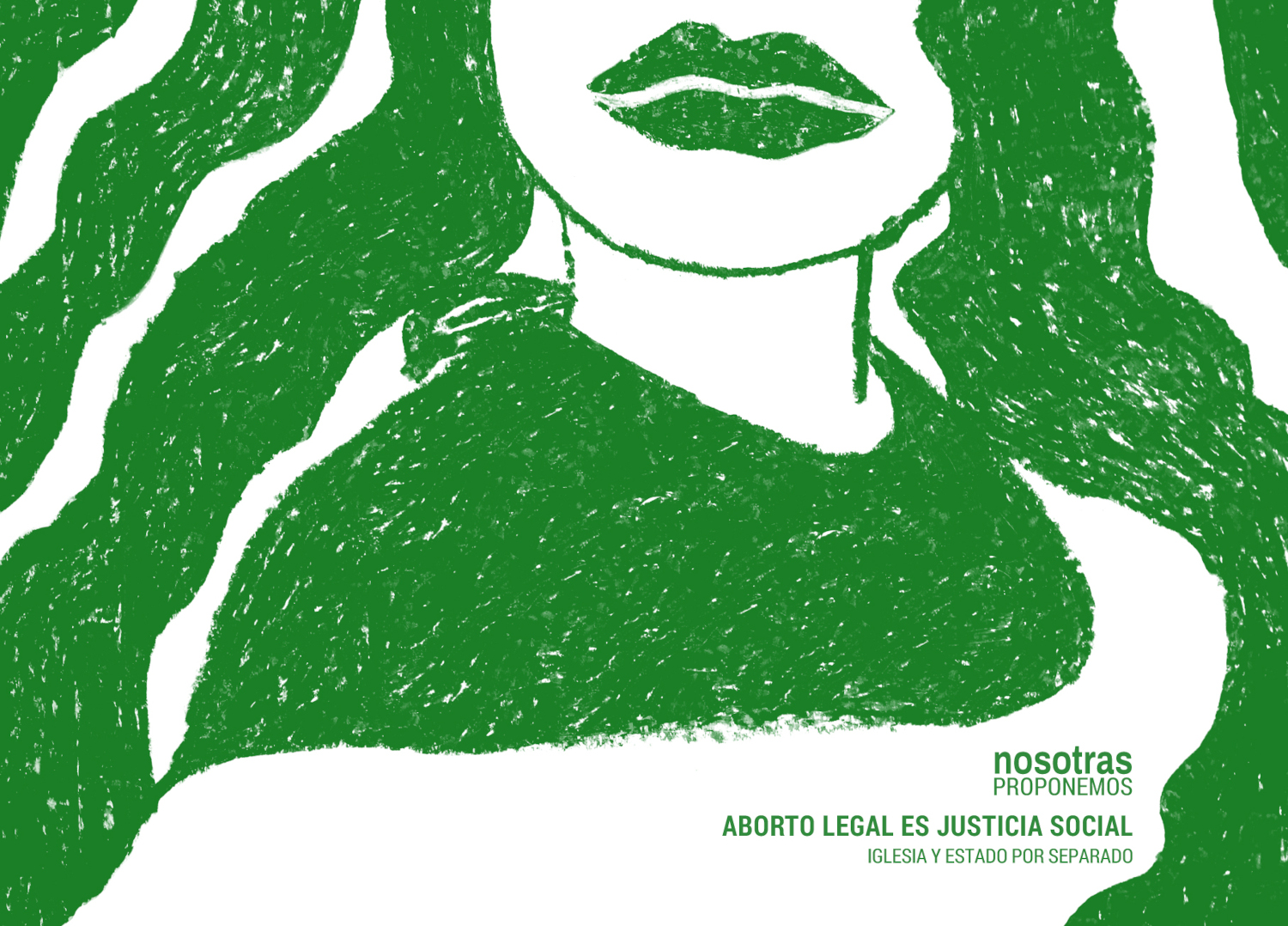Research
Nosotras Proponemos, Mujer [Woman], 2018, poster for the abortion legalisation campaign march, offset colour print © Nosotras Proponemos
The history of feminist art has been written from a predominantly English-speaking perspective. Nevertheless, many histories of feminist art have been written far from the power centres that disseminate their narratives in English, the lingua franca of contemporaneity. In the last thirty years Latin America has experienced an historiographic turn as it began to take into account art made by women. This article looks at the relationship between art history, art and feminist activism in Argentina from the 1970s to today.1
Feminisms between dictatorship and democracy
Between the end of the 1960s and the beginning of the 1970s, Argentine women artists joined feminist organisations such as the Unión Feminista Argentina [UFA, Argentine Women’s Federation]. One such was María Luisa Bemberg, who made the feminist activist films El mundo de la mujer [Women’s World, 1972] and Juguetes [Toys, 1978], which deconstructed the patriarchal society’s commandments articulated by industries focusing on women and education. These films, linked to second-wave feminism in Argentina, have been analysed in twenty-first century studies on art and feminism in Argentina.2
Feminist activism did not disappear during the dictatorship (1976–1983), but the term “feminism” was replaced by the word “women” or the name of a woman of historical significance. There arose organisations like Derechos Iguales para la Mujer Argentina [DIMA, Equal Rights for Argentine Women, 1976], the Asociación de Mujeres Argentinas [AMA, Association of Argentine Women, 1977, rebaptised in 1978 the Asociación des Mujeres Alfonsina Storni (AMAS, the Alfonsini Storni Women’s Association)], the Centro de Estudios Sociales de la Mujer [Women’s Social Studies Centre, linked to the Frente de Izquierda Popular (People’s Left Front), 1979], and, in Córdoba, the Asociación Juana Manso [Juana Manso Association, 1978]. During these years study groups played an important dynamic role. While the repressive system blocked political activism, women sought channels through which they could continue educational work in a situation largely characterised by insilio (“insile”, as opposed to exile, the experience of people who remained in the country during the dictatorship, marked by both isolation and resistance), a wounded identity and repressed memory.3
With Argentina’s defeat by the United Kingdom in the Malvinas (Falklands) war, the end of the dictatorship and the return to democracy, many exiled cultural actors were able to return home, including Ana Amado, Elsa Flores Ballesteros, Elda Cerrato and Marcia Schvartz. Activism gained a new visibility with the formation of groups like the Organización Feminista Argentina [OFA, Argentine Feminist Organisation, 1980], the Asociación de Trabajo y Estudio de la Mujer-25 de noviembre [ATEM, 25 November Association for Women’s Studies, 1982], and Libera [Free, 1982]. The year 1980 saw the first public feminist political demand, for joint custody of children, which was legalised in 1985 – prior to this, the father had exclusive custody. But the central struggle was for the legalisation of abortion, first put forward by the UFA in the 1970s and taken up starting in 1986 by a series of national women’s conferences that attracted larger numbers of women from all classes. The year 1993 was marked by the foundation of a national coordinating committee to demand the legalisation of contraception and abortion. In 2003 this new campaign adopted the green scarf as a powerful visual symbol representing life, nature and ecology, in a parallel with the white kerchiefs worn by the Madres de Plaza de Mayo [Mothers of the Plaza de Mayo], a women’s campaign for the truth about their sons and daughters who had been disappeared by the military government.

Nelly Richard, Masculino / Femenino: prácticas de la diferencia y cultura democrática, Santiago, Francisco Zegers Editor, 1993
One highlight in the artistic and cultural field during the post-junta period was the founding in 1983 – in the wake of a conference on female creativity – of Lugar de Mujer [A Woman’s Place], an organisation that sought to spotlight women as autonomous subjects with rights and subject to gender-based violence and social, economic and cultural discrimination or repression for their sexual choices.4 The organisers included the photographer Alicia D’Amico (who led a workshop on women’s self-image and the construction of identity), painters, tapestry makers and experimental filmmakers such as Narcisa Hirsch. The historic women’s march celebrating the return of democracy on 8 March 1984 was photographed by Alicia D’Amico, who also produced Podría ser yo5 [It Could Be Me], a visualisation of the labour performed by working people, including women – particularly the chapter “El ocio es de los otros. Las mujeres y el tiempo” [Free time is not for us. Women and time], a portrait of women living in poverty who perform domestic tasks or work as caretakers
There were a growing number of exhibitions by women artists. In 1984, 8 March was celebrated by exhibitions like La mujer en el arte [Women in Art] at the Museo de Arte Moderno and Raquel Forner, Aída Carballo, Ana Weiss de Rossi at the Museo Sívori in Buenos Aires. In 1986 and 1988, at the Centro Cultural Recoleta (CCR) in Buenos Aires, Monique Altschul curated the shows Mitominas I and II, two exhibitions of work by contemporary women artists that interrogated the myths conditioning female representation.6 La mujer en la plástica Argentina I [Women in the Argentinian Plastic Arts], curated by the art critic Rosa Faccaro (associated with Lugar de Mujer) at the Centro Cultural Las Malvinas in 1988, was probably the first show to examine feminist historiographic studies and practice in Argentina.7
The return to democracy opened up new fields of academic investigation. Art historians became eligible for research fellowships at the Universidad de Buenos Aires y del Consejo Nacional de Investigaciones Científicas y Técnicas (CONICET). Here, the keyword was not so much feminism as gender. Starting in the 1990s there was a critical examination of the established narratives that dominated Argentine art history in the nineteenth8 and twentieth centuries.9 The work of contemporary artists like Alicia Herrero and Graciela Sacco was no longer analysed from a biological perspective, but seen in terms of the social construction of subjectivities. This historiographic turn was influenced by the Chilean theoretician Nelly Richard’s book Masculine/Femenine10 and the lectures she gave at the Centro de Arte y Comunicación (CAyC) launched in the late 1980s. The impact of the social sciences and gender studies was manifested by the founding of the Instituto de Investigaciones en Estudios de Género de la Facultad de Filosofía y Letras at the Universidad de Buenos Aires.11 This historiographic trend was linked to third-wave feminism, focused on deconstructing narratives and processes of the construction of identity, and unravelling the matrix of colonial biologism that had been established by the Church and colonialist political structures in the colonies and continued under the subsequent independent republics: the view that there are only two biological and socially acceptable sexualities – male and female.
The exhibitions of the day also demonstrated the conceptual shift that occurred with the adoption of the perspective of gender. In 1994, three artists (Cristina Schiavi, Alicia Herrero and Ana López) staged the radical exhibition Violaciones domésticas [Domestic Violations] at the Espacio Giesso. Their work interrogated the matrix of gender that regulates household labour. Similarly, in 1995 and 1996 Adriana Lauría organised two editions of the exhibition Juego de Damas [Draughts] at the Museo Municipal de Bellas Artes Juan B. Castagnino, the Espacio Nave del Teatro Auditorium de Mar del Plata and the CCR. In 1997 Elena Oliveras curated Tajos bajos [Low Cuts]12 at the Centro Cultural Borges. The objective was to show work made by women artists and at the same time challenge heteronormative sexualities.

Mujeres Públicas, Todo con la misma aguja [All with the same needle], 2003, poster © Mujeres Públicas
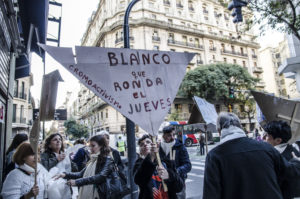
Cromoactivismo, Marcha contra el 2 x 1 [March against the 2 x 1], 2003, photo: Pablo Mehanna © Courtesy Pablo Mehanna
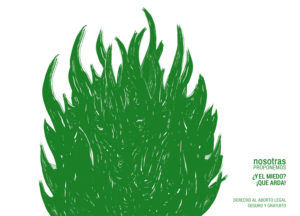
Nosotras Proponemos, Fuego [Fire], 2018, poster for the abortion legalisation campaign march, offset colour print © Nosotras Proponemos

Nosotras Proponemos, Mujer [Woman], 2018, poster for the abortion legalisation campaign march, offset colour print © Nosotras Proponemos
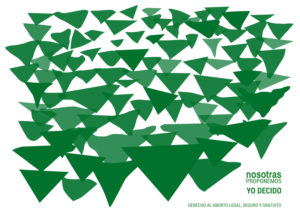
Nosotras Proponemos, Multitud de pañuelos [A multitude of kerchiefs], 2018, poster for the abortion legalisation campaign march, offset colour print © Nosotras Proponemos
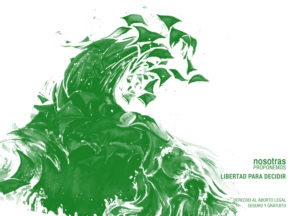
Nosotras Proponemos, Ola [Wave], 2018, poster for the abortion legalisation campaign march, offset colour print © Nosotras Proponemos

Nosotras Proponemos, Pañuelo [Kerchief], 2018, poster for the abortion legalisation campaign march, offset colour print © Nosotras Proponemos
The 21st century: feminism in the postcrisis period
The 2001 economic crisis detonated by the IMF led to the resignation of Argentine president Fernando de la Rúa and one of the most intense waves of social upheaval the country had ever known. The streets were flooded with protesters expressing their distrust of the political structures. This was the context for an upsurge of feminist groups at the intersection of social protest, street activism and feminism, such as Mujeres Públicas [Public Women, 2003], Belleza y Felicidad Fiorito (an art and community services group in a Buenos Aires slum, 2003), Serigrafistas Queer [Queer Silkscreen Makers, 2007] and Desesperadas por el ritmo [Desperate for Rhythm, 2014]. These organisations took up the struggle for legalised abortion, the right to creative activities for poor and excluded women, queer representational aesthetics and equal rights for women in the art world.
The twenty-first century has seen a critical revisionism from a feminist perspective in regard to work of the previous century. Starting in 2008 there has been a stream of articles,13 books14 and exhibition catalogues15 documenting, analysing and reinterpreting twentieth-century Argentine art. This historiographic moment coincided with what is considered the fourth wave of feminism, distinguished essentially by the upsurge of mass participation in feminist actions inaugurated by the Ni Una Menos [Not One Woman Less] movement against femicides.
A massive demonstration in Argentina with this slogan took place on 3 June 2015,16 inspiring a radical leap in the Latin American feminist movement. Beginning in 2015 the term feminism acquired a new legitimacy, coexisting with and eventually even replacing the term gender. This context gave rise to a multitude of feminist art collectives such as Cromoactivismo (2013), Nosotras Proponemos [We Women Propose, 2017] and La Lola Mora [named after a famous Argentine woman artist, 2018]. They emphasised the political meaning of colour and upheld the rights of artists considered as workers, the federalisation of feminist art and the recognition of women artists not just in Buenos Aires but throughout the country.
The country underwent further changes in terms of representation. In 2018, the Salón Nacional adopted a clause to ensure parity between men and women at every level, from admission to the composition of the jury and the handing out of prizes. This new rule was the fruit of struggle carried out by the feminist art group Nosotras Proponemos. Starting in 2021, the rules mandated quotas for trans and non-heteronormative identities. That same year saw the establishment of the 8M acquisition prize, independent of the salon, for work by women and LGBT+ artists to be taken in by the country’s national museums, where work by women now makes up only 20% of their collections. These public policies are aimed at preventing the reproduction of inequality. In the field of women’s rights, in December 2020 the right to legal, safe and free abortions became law.
This prominence acquired by feminism, with its presence in the streets, public discourse, the arts and publishing, made it a prime target. The rise of feminism was matched by the rise of an antifeminism spread by social media spewing out the discourse of the far right that came to power in December 2023 with the election of Javier Milei as president. The right to a legal, safe and free abortion is one of the achievements threatened by this political current seething with hatred for feminist artists and their work. This could be seen in the 2021 debate around the work of Fátima Pecci Carou, who was violently attacked on the internet for her themes and artistic practices (her exhibition centred on the figure of Eva Perón and using the language of manga and anime was attacked on social networks because of her feminist position and she was accused of plagiarism.) These intense polemics proved just how relevant images are and will be in the new order that threatens Argentina.
This article borrows from aspects of my other publications, including “Feminisms and Activisms in Contemporary Latin American Art” in Empowerment. Art and Feminism, ed. Andreas Beitin, Katharina Koch, Uta Ruhkamp (Wolfsburg: Kunstmuseum Wolfsburg, 2022), pp. 53–59, and “Activismo curatorial en la agenda de los feminismos” in Discursos intervinientes: mujeres y arte actual, ed. Lynda Avedaño Santana, María Antonia Blanco Arroyo, Mónica Carabias Álvaro (Madrid: Dykison, 2022), pp. 211–222. This article also incorporates material from “From the Rio de la Plata to the Extreme West: Feminist Historiographies of Art and Artistic Activism in Argentina and Chile”, to appear in the forthcoming issue of the Ikonotheka, and the chapter “Activismos feministas en el arte latinoamericano” of a book I am currently preparing for publication, Arte y diversidades en América Latina. Historias de artistas que rompieron el techo de cristal (Buenos Aires: Siglo XXI, 2024).
2
See María Laura Rosa, Legados de libertad. El arte feminista en la efervescencia democrática (Buenos Aires: Biblos, 2014) and Andrea Giunta, Feminismo y arte latinoamericano. Historias de artistas que emanciparon el cuerpo (Buenos Aires, Siglo XXI, 2018). English extended translation published as The Political Body. Stories on Art, Feminism, and Emancipation in Latin America (Oakland: University of California Press, 2023).
3
See Chango Illánez, “Exilio e insilio. Una mirada sobre San Juan, su universidad y las herencias del proceso”, Revista U. La Universidad, Año III, no. 19 (April 2006), last consulted on 15 December 2023, https://revista.unsj.edu.ar/numero19/exilio.htm
4
Georgina Gluzman, “Feminismos, educación, creatividad y libertad en la Buenos Aires posdictatorial. El caso de Lugar de mujer”, Caiana. Revista de Historia del Arte y Cultura Visual del Centro Argentino de Investigadores de Arte 18 (first semester 2021, pp. 110–127).
5
Alicia D’Amico, Elizabeth Jelin, Pablo Vila, Podría ser yo: Los sectores populares urbanos en imagen y en palabra (Buenos Aires: Ediciones de la Flor, 1987).
6
Rosa, op. cit., pp. 90–92.
7
Gluzman, op. cit.
8
Laura Malosetti Costa, “El rapto de cautivas blancas: un aspecto erótico de la barbarie en la plástica rioplatense del siglo XIX”, in Arte, historia e identidad en América: Visiones Comparativas, ed. Gustavo Curiel, Renato González Mello y Juana Gutiérrez Haces (Mexico: Instituto de Investigaciones Estéticas, UNAM, 1994), pp. 297–314, and “Una historia de fantasmas. Artistas plásticas de la generación del ochenta en Buenos Aires”, in VI Jornadas de Historia de las Mujeres y I Congreso Iberoamericano de Estudios de las Mujeres y de Género, Voces en conficto, espacios en disputa (CD-ROM, Buenos Aires: FFyL-UBA, 2000).
9
See Andrea Giunta, “La mirada femenina y el discurso de la diferencia”, en Estética y Crítica: los signos del arte, ed. Rosa María Ravera (Buenos Aires: Universidad de Buenos Aires y Asociación Argentina de Estética, 1999), pp. 11–15, and “Graciela Sacco: intervenciones del cuerpo/impresiones luminosas”, in Graciela Sacco, Escrituras solares: La heliografía en el campo artístico (Sacco: Rosario, 1994), pp. 58–89.
10
Nelly Richard, Masculino / Femenino: prácticas de la diferencia y cultura democrática (Santiago: Francisco Zegers Editor, 1993). [Translated by Duke University Press, 2004].
11
Founded in 1992 as the Área Interdisciplinaria de Estudios de la Mujer, in 1997 it became the Instituto Interdisciplinario de Estudios de Género, and in 2019, still at the Universidad de Buenos Aires, the Instituto de Investigaciones de Estudios de Género. See http://genero.institutos.filo.uba.ar/historia (last consulted 20 December 2023).
12
In Argentina the word “tajo” can also mean vulva (editor’s note).
13
Andrea Giunta, “Género y feminismo. Perspectivas desde America Latina”, Exit Book: revista de libros de arte y cultura visual 9 (2008), pp. 90–95.
14
María Laura Rosa, op. cit.; Georgina Gluzman, Trazos invisibles. Mujeres artistas en Buenos Aires (1890–1923) (Buenos Aires: Biblos, 2016); Andrea Giunta, Feminismo y arte latinoamericano… op. cit.
15
Cecilia, Fajardo-Hill, Andrea Giunta, Radical Women: Latin American Art, 1960–1985 (Los Angeles: Hammer Museum, 2017); Lemus, Francisco, ed., Tácticas luminosas: artistas mujeres en torno a la Galería del Rojas (Buenos Aires: Fundación Amalia Lacroze de Fortabat, 2019); Andrea Giunta, Puisqu’il fallait tout repenser (Paris: Delpire & co, 2021); Georgina Gluzman, El canon accidental. Mujeres artistas en Argentina (1890–1950) (Buenos Aires: Museo Nacional de Bellas Artes, 2021).
16
Words taken from a poem by Susana Chávez protesting against femicides in Guanajuato, México. The author of this poem was murdered in 2011.
Andrea Giunta is a senior researcher at the CONICET and professor of modern, contemporary and Latin American art at the Universidad de Buenos Aires, where she was awarded her doctorate. Her recent books include The Political Body. Stories on Art, Feminism, and Emancipation in Latin America (UCPress, 2023), Contra el canon. El arte en un mundo sin centro (Siglo XXI, 2020) and Puisqu’il fallait tout repenser (Delpire & co, 2021). She was the co-curator of Radical Women. Latin American Art, 1960–1985 (Hammer Museum, Brooklyn Museum and the São Paulo Pinacoteca) and executive curator of the Bienal 12 Mercosur, Feminine(s): visualities, actions and affections (2020). She is currently working with Igor Simões to prepare the exhibition Rosana Paulino: Amefricana (MALBA, 2024).
An article produced as part of the TEAM international academic network: Teaching, E-learning, Agency and Mentoring.
Andrea Giunta, "Historiography of feminist art in Argentina from the 1970s through today." In Archives of Women Artists, Research and Exhibitions Magazine, . URL : https://awarewomenartists.com/en/magazine/historiographies-de-lart-feministe-en-argentine-des-annees-1960-a-nos-jours/. Accessed 4 July 2025
